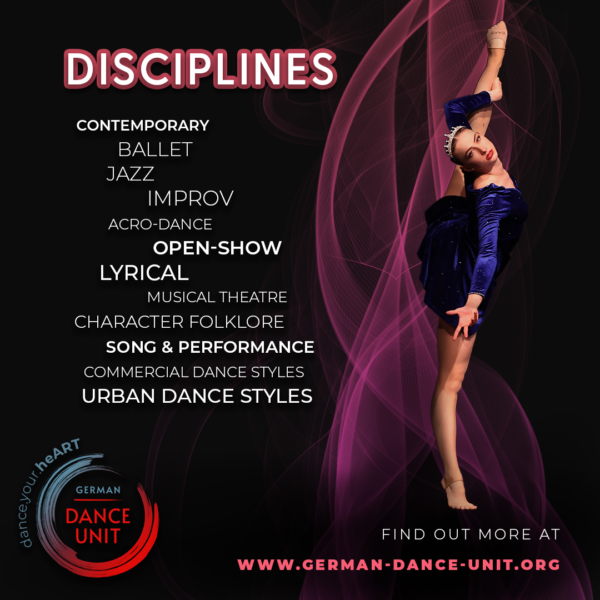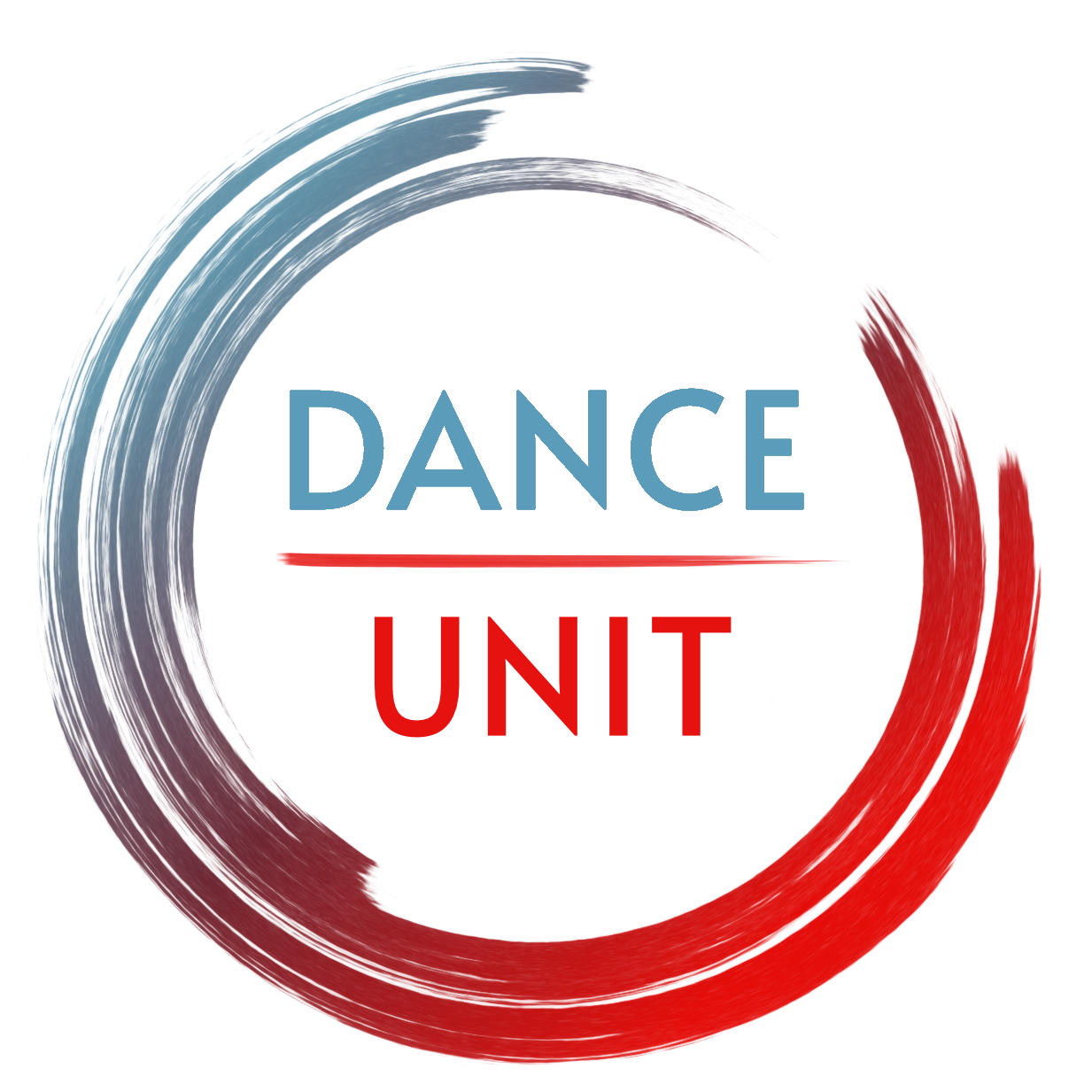Improv for “Performing Arts” und “Street Arts”
The dancers are encouraged to leave their heart on the dance floor and push their creativity and diversity to the limit. Before entering the stage, the dancers do not know which song they will be dancing to. The music is not announced in advance. Dance Unit provides the music. All improv pieces have a length of 60 seconds per dancer. Improv is only possible starting from the KIDS age group. Improv is divided into two categories: "Performing Arts" Contemporary, Modern Dance, Show Dance, Acro Dance, Classic Ballet, Lyrical Dance, Jazz Dance, Latin Dance etc. and "Street Arts" Hip-Hop, Krump, Hypedance, Popping, Locking, Breacking, House, Afrodance, Dancehall, Shuffle, Voguing, Tecktonic, Jumpstyle, Funk etc. For each category that has 41 or more starters per age group, the best 5-10 soloists will compete against each other again. Afterwards there will be a "DANCE OFF" final round with the "Top 2 Dancers". The judges will give an open evaluation in order to award the improv champion.
Urban Dance Styles
Urban Dance Styles encompasses a wide range of dance styles such as hip-hop, krump, hypedance, popping, tutting, locking, waving, gliding, sliding, skipwalking, jerking, stomping, house, dancehall, jacking, lofting, footwork, shuffle, whaacking, voguing, tecktonic, jumpstyle, whining and many more, which have become popular in the dance scene and have developed into an international and popular form of expression of youth culture, which has now also become part of commercial dance styles. In this discipline, dance must express the specific dance styles, offer a theme or direction that expresses creative ideas, dance images and stylized choreographies.
Commercial Dance (MTV-Dance/Videoclip Dance)
Commercial is a highly choreographed dance style and encompasses a variety of vibrant disciplines. The choreography can include elements of jazz, funk, hip-hop or other styles, inspired by the influence of MTV, variety shows and popular singers or club dances. This dance style is most commonly seen in MTV music videos, advertising campaigns, television and movies. The emphasis is on a combination of presentation, energy, expression and performance.
Ballet - all styles, incl. point
Ballet is a dance style associated with academic methods such as the Cecchetti method (Italy), the English method, the Vaganova method (Russia) and the Balanchine method (USA). In this category, a recognized ballet repertoire piece as well as neoclassical ballet styles can be used. Traditional ballet technique is used. In the MINIS category, we strongly advise teachers to choose age-appropriate variations, which may be adapted to match abilities. The jury attaches particular importance to good technique and, above all, attitude. The feeling of ballet must be transmitted, which is presented in a meaningful way with the respective technique, posture and stage presence. Ballet shoes must be worn in this discipline (slippers, pointe shoes or ballet character shoes). Pointe dancing is only permitted from the age of 12 (this applies to all categories or disciplines).
Folklore/Charakter Dance
Character dance is a specific subdivision of classical dance. It is the stylized representation of a traditional folk or national dance from all over the world. The music used in the performance as well as the costumes must be relevant to that country. The music must be national/folkloric that reflects the typical sound of the music in that country. Original choreography is permitted, but not required. Popular character dances include the national dances of China, Korea, Hungary, Russia, Poland, Italy and Spain: Csárdás, Mazurka, Tarantella, Flamenco etc.
Acro
A routine that combines acrobatic elements / tricks and dance of any style with a smooth transition between the two.
Acrobatic elements include for example flexibility, walkovers, backovers, aerials (sideways, front), back handsprings etc. Dancers should show total control of their body and the tricks they perform. All acrobatic elements should be linked to a clear dance choreography throughout the routine. For duo/trio/quartet, small group and group, partner work and group tricks should also be included in the routine.
Contemporary/Modern
Contemporary dance has established and recognized dance styles and techniques based on the famous expression of choreographers such as Graham, Ailey, Limon, Cunningham and Horton or - more in today's trend - Akram Kahn, Forsythe, Crystal Pite, Sidi Larbi Cherkaoui, Jiří Kylián etc.
Contemporary Dance is a collection of methods and techniques based on the principles of ballet, modern and post-modern dance. Contemporary dance allows for a wider range of movements that do not necessarily stick to the strict body lines of classical ballet.
The images, ideas and emotions of the dance can be accompanied by a variety of sounds, from music to spoken word to silence, if it suits the theme of the dance.
Open – Show (also known as Production Number)
This discipline is best described as impactful dance with entertaining choreography, a clear story and a connecting theme. The choreographic creation may use all styles of dance to bring the piece together into a fully structured performance (an innovative theme, an original story, the main thread).
The choreography should be based on an idea and creativity, accompanied by appealing costumes, a strong presentation and expression suitable for the dancers involved.
For groups of 11 dancers or more, the time limit is set at 3:00 to 4:30 minutes.
Please note: Musical and dance films that are performed must be entered in the Musical Theater discipline.
Musical-Theater
This discipline combines acting and dance. However, it must not be sung live. The story, the emotions and the role should be clearly recognizable. It is important that the dancer reflects the emotions of the song. The music to be danced to should come from an original musical, dance or music film (e.g. Hamilton, Sister Act, The Greatest Showman, etc.).
Jazz Dance
This is a discipline in which classic jazz dance elements are in the foreground (jazz walks, fan kicks, jazz pirouettes and more). There are many ways to present jazz, such as Classic Jazz, Theater Jazz, Afro-Jazz, Street Jazz or Latin Jazz.
Jazz music is an important part of the jazz choreography. Choosing the right music will enhance the naturally required jazz dance elements and also show an understanding of musicality, synchronization and dynamics for the overall visual execution of the choreography.
All jazz dance pieces must show a clear understanding and creative expression that is informed and inspired by the various genres and styles of jazz dance .
Lyrical Dance
Lyrical dance is a dance style that combines the basic techniques of jazz, ballet and modern dance. It can also include acrobatic elements. No particular style dominates, but the styles serve as a form of artistic expression. The dancer dances to music with lyrics, which serves as inspiration for the dancer's movements and expression. Strong feelings such as love, joy, romance etc. are shown through movements. Song lyrics may be interpreted and presented through dance, but also integrated acting moments from the field of dance theater may be used.
According to Jennifer Fisher, lyrical dance is strongly associated with clearly expressed emotional moods, fast-moving choreographic strategies, underlining of song lyrics and exact unison in group form. The style is generally danced with more accentuation than ballet, but not in the poly-rhythmic style typical of pure jazz.
Tap Dance
Creating syncopated rhythms with the use of tap shoes. The performance must contain the tap technique and primarily tap work. It is not permitted to pre-record tap beats on the competitor's music.
Tap shoes must be worn in this discipline. Irish shoes are not permitted in the tap discipline.
If Irish shoes are worn, the dance should be entered in the National Folklore division.
Timing begins with the very first step of the tap dance or the first note of the music, whichever comes first.
The timing ends with the end of the music or with the last tap
beat, depending on which is the last.
SIng Performance
Live singing is required in this discipline.
Any song (including own lyrics/songs or covers) and any dance style are permitted.
The dance or movements should match the song to support the song as an overall performance. The performance should show presentation and acting skills to emphasize the required characterization or comedy.
Playbacks or half-playbacks are not permitted.
A maximum of 6 microphones (3 hand microphones + 3 head sets) are available.


